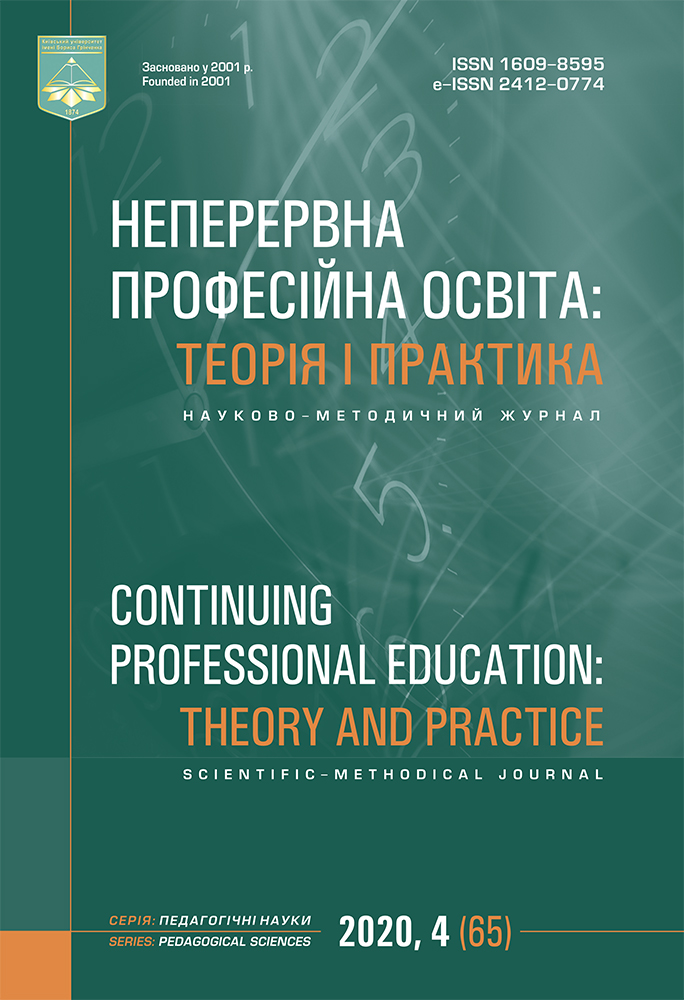APPLICATION FEATURES OF ELECTRONIC TEACHING MATERIALS IN PROFESSIONAL TRAINING OF SPECIALISTS IN THE FIELD OF PHYSICAL EDUCATION AND SPORTS
DOI:
https://doi.org/10.28925/1609-8595.2020.4.8Keywords:
cloud services, electronic teaching tools, electronic textbook, multimedia teaching tools, specialists in physical education and sports, visualization toolsAbstract
The article considers the peculiarities of the use of electronic learning tools in the process of training future specialists in physical education and sports. An analysis of the scientific literature on the use of electronic tools in the educational process in higher education is conducted. The experience of using e-learning tools in the process of training specialists in physical education and sports at Zaporizhia National University is generalized. A classification has been formed and four groups of e-learning tools have been substantiated for the training of future specialists in physical education and sports. The first group includes an electronic textbook. It is established that its educational functionality is higher than that of paper. The second group included quasi-professional learning tools using Google Wave, Google Groups, Zoom, FreeConferenceCall, Google Meet, Kahoot and QUIZIZZ, as well as LearningApps tools, which gave students the opportunity to create their own interactive exercises and learning games. The third group included multimedia teaching tools for creating presentations using Prezi, online application for animated video presentations PowToon, video editors Windows Movie Maker and VSDC Free Video Editor, visualization tools using online graphics services Google Developers, Easel.ly, Piktochart, Infogr.am, graphic editors Adobe Photoshop, The GIMP, Paint.net, PhotoInstrument, as well as tools for reproducing educational virtual reality using mobile VR-helmets OCULUS GO, MIRAGE SOLO, GEAR VR. The fourth group of e-learning tools in the training of future specialists in physical culture and sports included e-learning tools and its components, in particular, software and hardware Moodle, which allows you to develop exercises and tests to consolidate theoretical material and generalize knowledge of specialists in physical culture and sports. Scientific and methodological substantiation and recommendations on the use of electronic learning tools in the process of training specialists in physical culture and sports are provided.References
Antonova, O. Ye., Familiarska, L. L. (2019). Vykorystannia tsyfrovykh tekhnolohii v osvitnomu seredovyshchi zakladu vyshchoi osvity [Use of digital technologies in the educational environment of higher education]. Vidkryte osvitnie E-seredovyshche suchasnoho universytetu. Spetsvypusk «Novi pedahohichni pidkhody v STEAM osviti», 10–22. https://doi.org/10.28925/2414-0325.2019s2
Burtovyi, S. V. (2014). Elektronni zasoby navchannia – vid teorii do praktyky [E-learning tools – from theory to practice]. KZ «KOIPPO imeni Vasylia Sukhomlynskoho».
Vember, V. P. (2006). Navchalno-metodychni vymohy do elektronnoho pidruchnyka. Naukovyi chasopys NPU imeni M. P. Drahomanova. Seriia № 2. «Kompiuterno-oriientovani systemy navchannia», 4 (11), 50–56.
Vovk, O. B. (2015). Systemy elektronnoho navchannia – novi formy suchasnoi osvity [E-learning systems – new forms of modern education]. Matematychni mashyny i systemy, 3, 79–86.
Vetchanin, Ye., Horbatovskyi, D. (2020). Vykorystannia virtualnoi realnosti v osvitnomu protsesi ta proforiientatsiinii roboti na prykladi prohramnoho produktu VRANALYTICS [Usage of virtual reality in the educational process and vocational guidance on the example of «VRANALYTICS» software]. Osvitolohichnyi dyskurs, 1 (28), 80–93. https://doi.org/10.28925/2312-5829.2020.1.7
Gryzun, L. E. (2001). Dydaktychni osnovy stvorennia suchasnoho kompiuternoho pidruchnyka: dys…. kand. ped. nauk: 13.00.09 [Didactic base of contemporary computer textbook design: Candidate’s thesis: 13.00.09]. KhDPU.
Klopov, R. V. (2009). Osoblyvosti zastosuvannia multymediinykh tekhnolohii u vyshchii fizkulturnii osviti [Features of application of multimedia technologies in higher physical education]. Visnyk Chernihivskoho derzhavnoho pedahohichnoho universytetu im. T. H. Shevchenko. Seriia «Pedahohichni nauky. Fizychne vykhovannia ta sport», 69, 265–270.
Maltseva, T. M., Kovtun, O. V, Chala, O. I. (2017). Zastosuvannia informatsiinykh tekhnolohii u pidhotovtsi fakhivtsiv z fizychnoi kultury i sportu [The use of information technology in the training of specialists in physical culture and sports]. Naukovo-metodychni osnovy vykorystannia informatsiinykh tekhnolohii v haluzi fizychnoi kultury ta sportu, 1, 65–68.
Svatiev, A. V. (2016). Zastosuvannia informatsiino-komunikatsiinykh tekhnolohii u profesiinii pidhotovtsi maibutnikh fakhivtsiv fizychnoho vykhovannia ta sportu [The Use of Information and Communication Technologies in Professional Training of Future Specialists of Physical Education and Sport]. Pedahohika formuvannia tvorchoi osobystosti u vyshchii i zahalnoosvitnii shkolakh, 48, 194–203.
Khoruzha, L. L., Proshkin, V. V., Hlushak, O. M. (2020). Kompetentnisnyi rozvytok vykladachiv vyshchoi shkoly zasobamy tsyfrovykh tekhnolohii [High school teachers’ competence development by means of digital technologies]. Informatsiini tekhnolohii i zasoby navchannia, 78 (4), 298–314. https://doi.org/10.33407/itlt.v78i4.3042
Bakhmat, N., Maksymchuk, B., Voloshyna, O., Kuzmenko, V., Matviichuk, T., Kovalchuk, A…. Maksymchuk, I. (2019). Designing Cloud-oriented University Environment in Teacher Training of Future Physical Education Teachers. Journal of Physical Education and Sport, Supplement Issue, 19 (192), https://doi.org/1323–1332. 10.7752/jpes.2019.s4192
Bodsworth, H. & Goodyear, V. A. (2017). Barriers and facilitators to using digital technologies in the Cooperative Learning model in physical education. Physical Aducation and Sport Pedagogy, 22 (6), 563–579. https://doi.org/10.1080/17408989.2017.1294672
Burne, G., Ovens, A., Philpot, R. (2018). Teaching Physical Education with Digital Technologies: a self-study of practice. Rebescolar, 2, 93–108. https://www.researchgate.net/publication/331262092.
Gaebel, M. (2015). E-learning in the European Higher Education Area. https://enqa.eu/wp-content/uploads/2015/12/E-learning-in-the-European-Higher-Education-Area_Gaebel.pdf.
Khomik, O. & Kovalchuk, O. (2018). Practical covrse-conference using youtube as interartive teaching form of professionals in higher educational institutions. Scientific electronic professional edition. Educological discourse, 1–2 (20–21), 312–324. https://doi.org/10.28925/2312-5829.2018.1-2.
Popova, E. A., Baranov, V. V. (2018). SMART technologiesin training of future teachers of physical culture. Primo Aspeсtu, 4 (36), 145–150.
Roche, L. & Gal-Petitfaux, N. (2017). Using 360° video in Physical Education Teacher Education. In P. Resta & S. Smith (Eds.), Proceedings of Society for Information Technology & Teacher Education International Conference (pp. 3420–3425). https://www.learntechlib.org/primary/p/178219/
Roliak, A. O. (2020). Professional education of teachers in physical training and health: the experience of Denmark. Pedagogy of physical culture and sports, 24 (3), 143–150. https://doi.org/10.15561/26649837.2020.0307.
State of the MOOC 2017: A Year of Privatized and Open Education Growth. Online Course Report (2018). https://www.onlinecoursereport.com/state-of-the-mooc-report/.
Varchenko-Trotsenko, L., Tiutiunnyk, A., Terletska, T. (2019). Using video materials in electronis learning cources. Open educational e-environment of modern University, Special edition, 375–382. https://doi.org/10.28925/2414-0325.2019s34.
Downloads
Published
How to Cite
Issue
Section
License
Copyright (c) 2020 Julia Barkova

This work is licensed under a Creative Commons Attribution-NonCommercial 3.0 Unported License.



